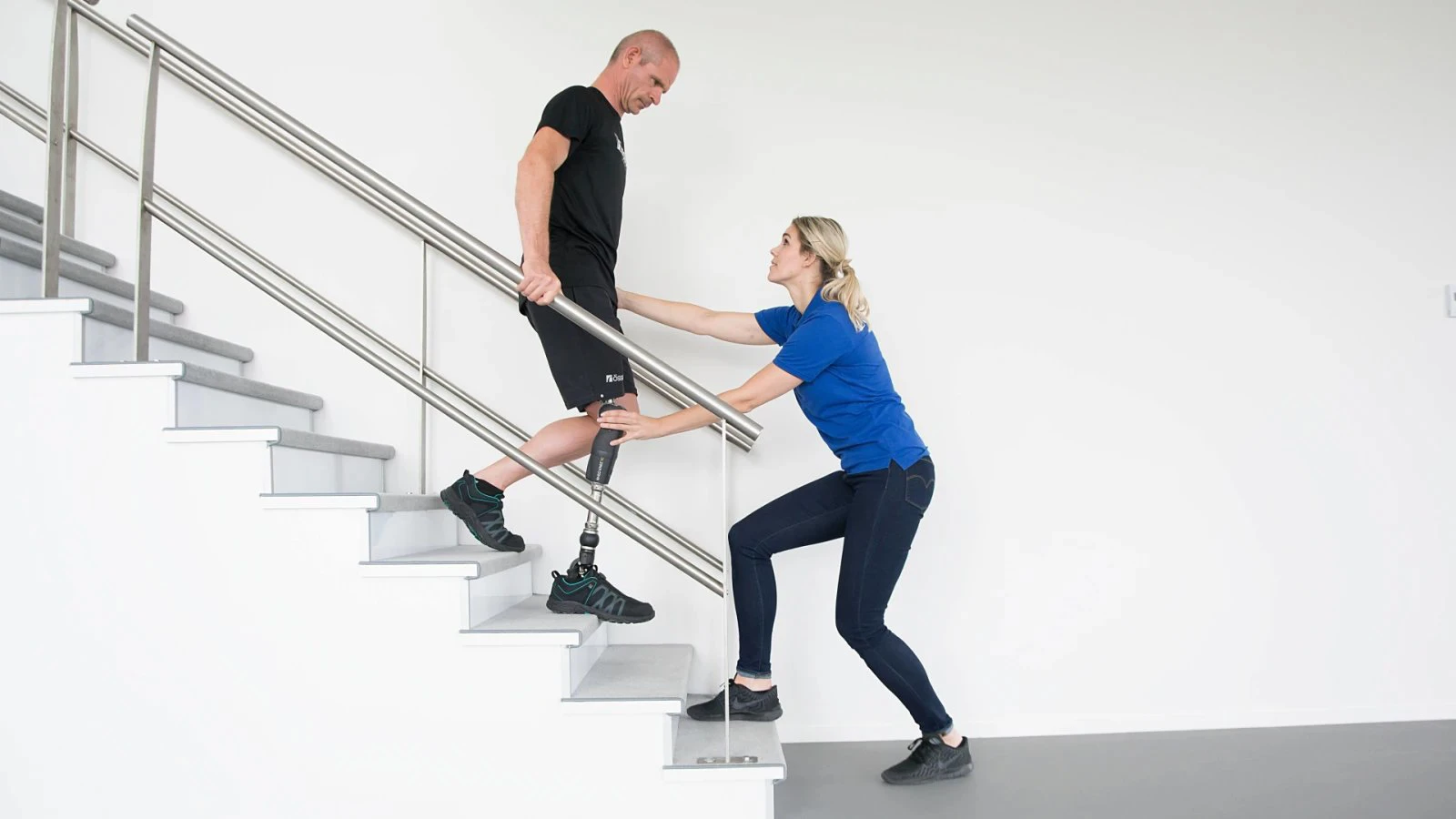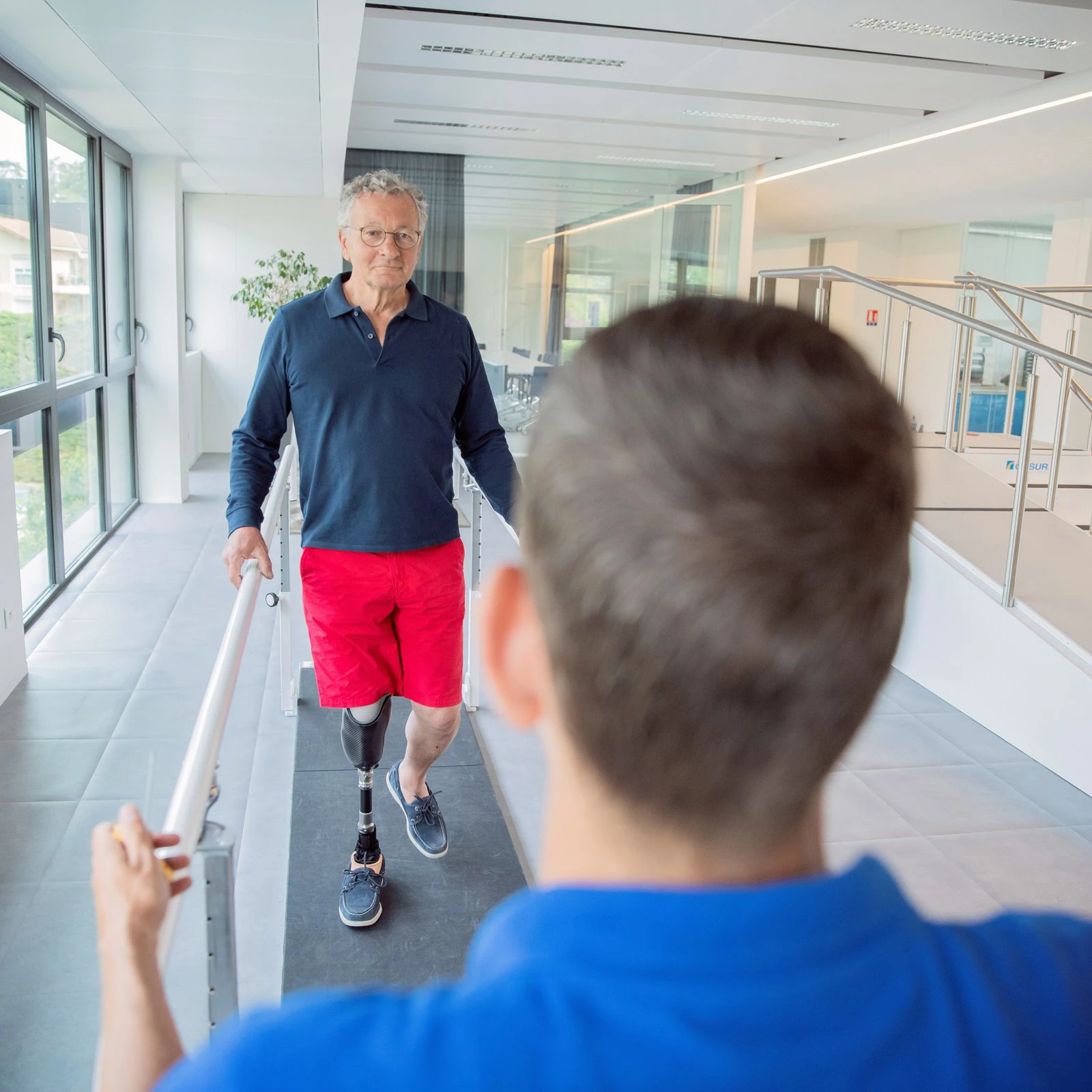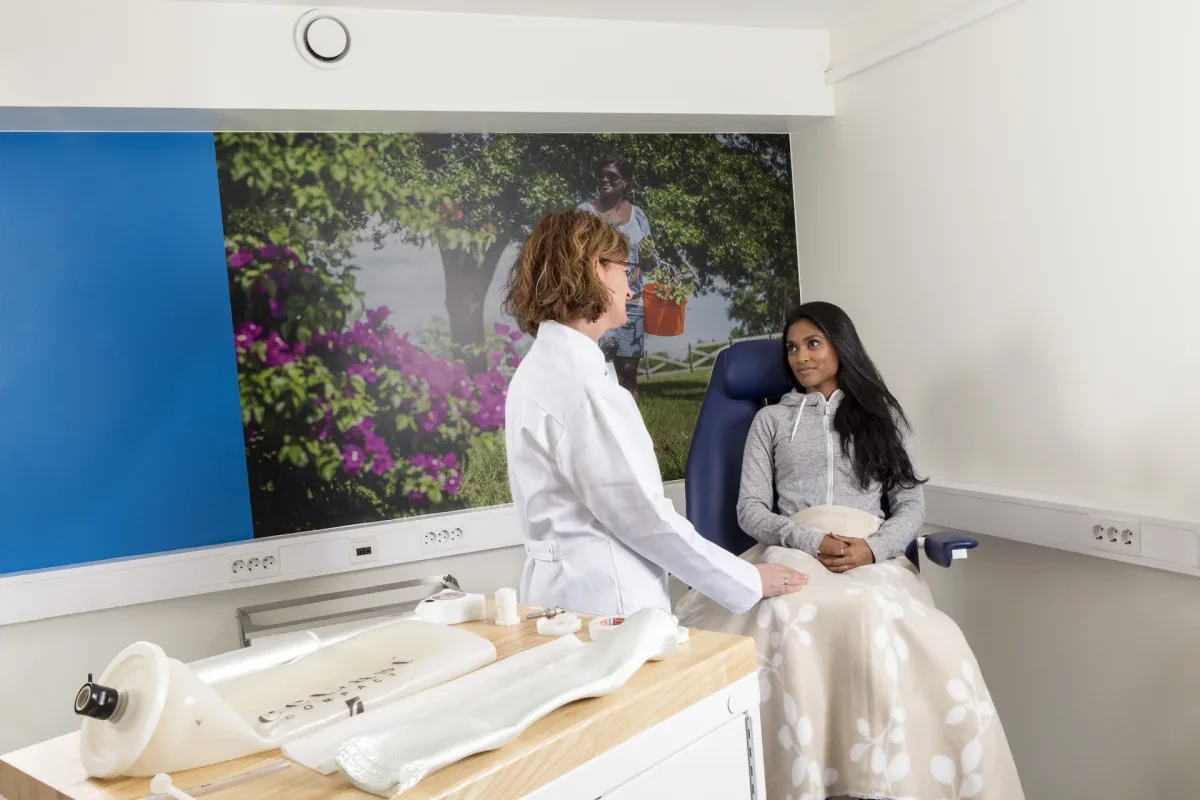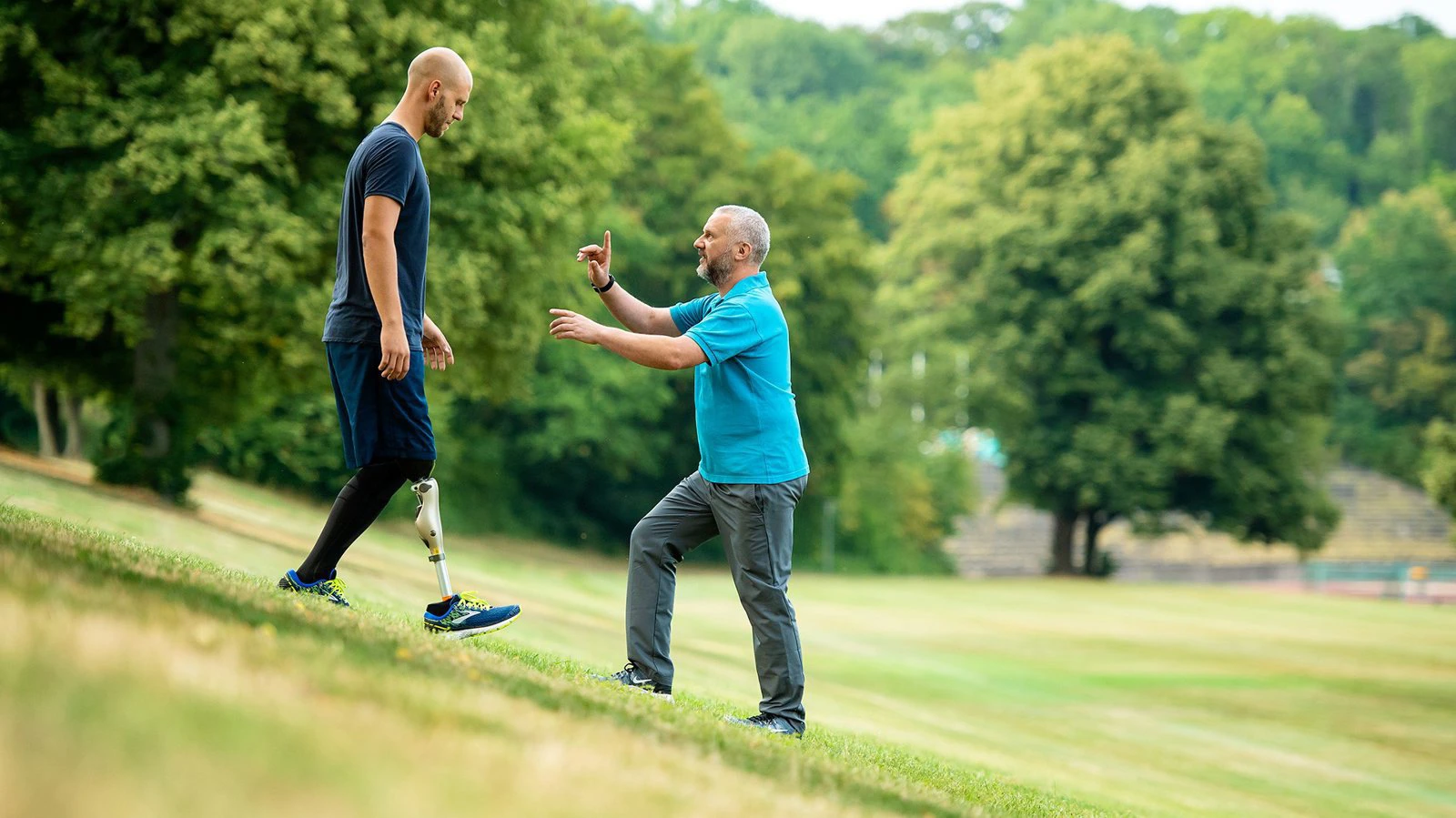Once the stump has healed, you will start with light exercises. You will learn to maintain your balance, activate your muscles and regain confidence in your body.
Goal: reduce swelling and learn to move again (without a prosthesis).
Welcome To Amputee Care Center
powered by Spronken
A good rehabilitation programme, tailored entirely to your needs, is just as important after an amputation as a well-fitting prosthesis. It helps you regain confidence in your body and enables you to do the things that are important to you again.
At Amputee Care Center (ACC), a multidisciplinary team is ready to help you rehabilitate after an amputation. We coordinate our programme with your healthcare providers to ensure that your recovery is as smooth and quick as possible.
Contact us by completing the Contact Form or by calling +32 (0)470 500 888. We are at your service.

After the operation, the rehabilitation process usually starts in hospital. You will then work on your recovery at ACC under the supervision of a multidisciplinary team. This includes:
At ACC, we are happy to work together with your doctor at the hospital. This way, we can guarantee that all steps of your recovery are fully coordinated.
Everyone recovers at their own pace, but rehabilitation usually proceeds in the following stages:
Once the stump has healed, you will start with light exercises. You will learn to maintain your balance, activate your muscles and regain confidence in your body.
Goal: reduce swelling and learn to move again (without a prosthesis).
You actively work on strengthening your body. This includes exercises on a balance board, customised strength training, or learning to move with crutches or a walking frame.
Goal: become stronger and prepare for using the prosthesis.
With the help of the physiotherapist and prosthetist, you will learn step by step how to move with a prosthesis. With a leg prosthesis, you will learn to stand, walk and shift your weight again. With an arm prosthesis, you will learn to grasp, hold and perform fine motor skills.
Goal: to gain confidence in your prosthesis.
You will learn how to use your prosthesis in everyday life. This goes beyond just moving: it is about learning to resume your activities. Think of climbing stairs, cooking, cycling, typing, working or pursuing hobbies.
Goal: to regain your independence and integrate your prosthesis into your life.
Together, we will look at how you can function safely and comfortably at home. If necessary, we will help you adapt your home or workplace. The prosthetist will continue to monitor you and adjust the prosthesis as you get stronger or your needs change.

No two programmes are the same. Some people can resume daily activities after just a few weeks, while others need more time. Our team ensures that the prosthesis, exercises and guidance are always tailored to your recovery. We regularly evaluate, together with the rehabilitation doctor, whether the programme remains realistic and achievable and how we can best help you.
It is important to know that rehabilitation takes time and effort. It is therefore normal to experience muscle pain or discomfort, especially in the beginning. Your body is still adjusting. Our therapists keep a close eye on this and ensure that your limits are respected. We build everything up slowly, at your pace.

A good recovery starts with good preparation. Even before the operation, we invite you for an introductory meeting. We get to know you, discuss what will happen and what steps will follow. We also look together at which aids or prostheses may be possible later on. This preparation means you know what to expect and we can start your rehabilitation quickly and in a targeted manner after the operation.
After the amputation, we closely monitor the healing process. We ensure that the stump heals properly and takes on the right shape for wearing a prosthesis. We also pay attention to wound care, swelling and any pain.
Together with the hospital and the rehabilitation team, we closely monitor your recovery. As soon as it is medically safe to do so, we start with light exercises to keep the muscles active and promote mobility.
Once the stump has healed sufficiently, the test phase begins. You will be given an evaluation prosthesis that allows us to assess the fit, comfort and functionality. This enables us to adjust everything until it fits perfectly. We use modern techniques, such as 3D scans, to create a prosthesis that fits your body and meets your needs perfectly. Sometimes it is even possible to start with a basic prosthesis within a single day.
This also marks the next step in your rehabilitation. You will learn how to use a prosthesis and together we will build strength, balance and confidence. For example, you will learn to walk again or grasp objects in a way that feels safe and natural. Our specialists will provide you with intensive guidance and adapt the programme to your pace.

Once the stump is stable, we will make your final prosthesis. It will be fully customised, based on everything we learned during the test phase. We will explain how to best use and maintain the prosthesis and how to combine it with your daily activities.
Once we have completed the rehabilitation process, that does not mean we say goodbye. We will see you regularly for check-ups and maintenance. This ensures that you continue to move well in the long term.
We make rehabilitation programmes for children as fun and accessible as possible. Our team specialises in helping children rehabilitate and cope with their prosthesis in a playful way. We like to actively involve the family in every step, so that everyone knows what is happening and how they can support the child.
Rehabilitation after an amputation requires commitment, but you are never alone. The ACC team is by your side, every step of the way. Together, we ensure that you regain the freedom to move, work and live the way you want.
Contact us by completing the Contact Form or by calling +32 (0)470 500 888. We are at your service.
The rehabilitation process usually starts as soon as the wound has healed sufficiently and your doctor gives you permission to start exercising. In the first few weeks, the focus is on wound care, pain relief and learning to move again without a prosthesis.
The duration varies from person to person and depends on your condition, the type of amputation and your recovery rate. On average, a complete programme (from surgery to independent mobility with the final prosthesis) takes several months. Our team closely monitors your progress and adapts the programme to your pace.
During the programme, you will work with a multidisciplinary team: a rehabilitation doctor, physiotherapist, occupational therapist, psychologist and prosthetist. They coordinate their guidance so that you receive the best possible support in every area.
In the case of a leg amputation, the emphasis is on balance, stability and walking training. In the case of an arm amputation, rehabilitation focuses more on coordination, hand function and learning to perform daily activities with the prosthesis. In both cases, it is all about strength, control and independence.
Under supervision, you will practise balance, muscle strength, coordination and functional activities such as climbing stairs, getting dressed or grasping objects. The exercises will be tailored to your type of amputation and personal goals.
Once your stump has healed properly and remains stable, we will start the trial phase. You will receive an evaluation prosthesis that allows us to assess the fit and comfort. This enables us to make any necessary adjustments before your final prosthesis is made.
Rehabilitation usually starts in hospital or a rehabilitation centre. After that, you continue working with our team at ACC. We coordinate our support closely with your doctor and therapists to ensure a seamless transition.
Yes, an amputation has not only a physical but also an emotional impact. That is why we work with psychologists at ACC who provide mental support during the various phases of recovery.
We use a playful approach with children. We integrate exercises into play, so that rehabilitation is accessible and fun. The family is closely involved in the guidance and follow-up.
Everyone has good days and bad days during rehabilitation. Sometimes it seems to stand still for a while, but that is part of the process. Together with the rehabilitation doctor and therapists, we will then look at what is going on. Maybe your body needs rest, or we need to adjust the exercises or the prosthesis. We will continue to guide you step by step until you feel progress again.